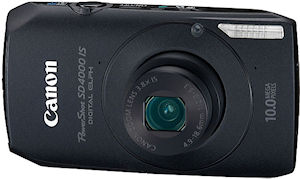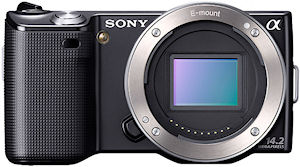
Today we’re posting a review of a simple and cheap camera, the Nikon Coolpix L22. I’ve also got the Nikon Coolpix L22 photo gallery online too. Click the link for the full review of the camera.
Read our review
New to the Digital ELPH (AKA Digital IXUS) line-up is the all-new Canon PowerShot SD4000 Digital ELPH (also known as the Canon Digital IXUS 300 HS). Unlike your average compact camera, this one’s pretty unique - it combines the “wide and fast” 3.8X zoom lens with a starting aperture of f2.0 (first seen in Canon’s own PowerShot S90) along with manual exposure controls (a rarity in Canon’s IXUS/ELPH line) and a new back-illuminated CMOS image sensor (which has found its way into at least one model in every camera maker’s current lineup).
The new 10 megapixel backlit CMOS image sensor allows the camera to take better quality images (ie less noise) than conventional CCD sensors traditionally used in compact cameras. That means, in theory, that you could use higher ISO settings (which are especially useful shooting in low-light) with lower noise levels… but we’ll put that to the test once we review the PowerShot SD4000 Digital ELPH in the near future.

Canon PowerShot SD4000 IS Digital ELPH
AKA Digital IXUS 300 HS
(Stylish compact camera)
- 10 effective megapixels (Backlit CMOS sensor)
- 28 – 105 mm (f2.0 – f5.3) 3.8X optical zoom lens
- Optical image stabilization
- 3.0 inch widescreen LCD (230,000 pixels)
- Full manual exposure controls
- Face, smile, wink and blink detection [Facepalm]
- 720p (1280 x 720) 30 FPS movie mode with stereo sound
“High speed” QVGA (320 x 240) movies also available at 240 FPS
- Takes SD, SDHC and SDXC memory cards
- Uses a lithium-ion battery
- Available in June for $350
- Comes in your choice of silver, black, red or white
Before this, the only players in the compact, interchangeable lens camera arena were Olympus, Panasonic and Samsung. Well, Sony hasn’t been sitting down lately as they’ve prepared two interchangeable lens cameras of their own to join in the fun. The brand new NEX-3 and NEX-5

Sony NEX-3/NEX-5
(Compact interchangeable lens cameras)
- 14.2 effective megapixels (EXMOR APS-C CMOS sensor, 1.5X crop)
- New Sony E-mount (1.5X crop factor)
Compatible with Alpha mount lenses (sans autofocus ability) via adapter
- 3 inch ‘Sony TruBlack’ LCD (921,000 pixels) with two separate hinges for tilting
- Proprietary port where you can attach an external ‘popup’ flash or optical viewfinder
- ISO speed range of 200 - 12800
- Live view only with face and smile detection
- Auto HDR (High dynamic range) takes three pictures and combines them into one for improved dynamic range
- Handheld twilight/anti blur modes take six pictures and combine them into one for lower noise and sharper pictures
- Sweep Panorama mode automatically creates panoramas (up to 23 megapixels large) as you pan the camera
- 3D Photo feature in the works; will be available via future firmware update from Sony
- 7 FPS continuous shooting mode (up to 8 RAW or unlimited JPEG)
- Full manual controls with RAW mode
- 25 point AF
- HD movie mode with stereo sound recording, continuous AF, optical image stabilizer and dedicated start/stop button
NEX 3: 720p Standard HD (1280 X 720) movies in H.265 codec
NEX 5: 1080p Full HD (1920 X 1080) movies in AVCHD codec; 720p option (same as NEX3) available
- Dual memory card slots for SD/SDHC/SDXC and Memory Stick Duo
- Uses a lithium-ion battery (NP-FW50)
- NEX 3: Available in July for $550 (with 16 mm pancake lens) or $600 (with 18-55 mm kit lens)
NEX 5: Available in July for $650 (with 16 mm pancake lens) or $750 (with 18-55 mm kit lens)
Along with their brand new “E-mount”, Sony also announced three new lenses to go along with this new system and they are:
- $300: 18 - 55 mm f3.5 - f5.6 “kit” lens with optical image stabilizer
- $250: 16 mm f2.8 “pancake” lens (No stabilizer)
- $800: 18 - 200 mm f3.5 - f6.3 super-zoom lens with optical image stabilizer
What’s unique about that 16 mm pancake lens is that you can actually attach (additional) conversion lenses to turn it into an ultra-wide angle/fisheye 12 mm lens. No word yet if the conversion adapter will be included with the lens or sold separately (but knowing Sony, it’ll most likely be the latter).






